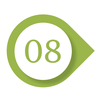We organise events for children, adolescents and adults who wear orthoses or prostheses.
We provide training in the everyday use of your prosthesis with you.
Make an appointment by phone or send us a message!
We give you the overview!
A prosthesis, step by step
Regardless of whether you’re affected before or after an amputation, whether you’re affected yourself or someone close to you – we’re happy to answer all your questions in a non-binding consultation, over the phone or on site. Our interdisciplinary consultation hours also offer the opportunity to discuss your individual situation regarding your prosthesis. Initial contact usually occurs only after the amputation.
The following sequence usually includes rather general points, although individual influences may cause changes and define time frames.

There are various causes that make an amputation on the leg necessary.
An amputation is typically decided when there is no prospect of maintaining the affected body part with sufficient functionality.
During the amputation, the doctor trying to preserve as much muscle tissue as possible to keep the residual limb stable, supportable and mobile. This is important, because the prosthesis is later applied to the residual limb. The quality standard for the area of lower limb prosthetics published by the German Society for Interprofessional Supply of Medical Devices (DGIHV) describes the parameters that constitute a resilient limb for each amputation level.
Sometimes we are involved in the amputation discussion even before the surgery in order to clarify with the operating doctor the course of the amputation should optimally be carried out so that the subsequent prosthesis can function as well as possible.

A residual limb needs attention to assume the load on a prosthesis and its control. For interim fittings, the residual limb consolidating measures are generally carried out in hospital a few days after the amputation in order to begin residual limb conditioning to prepare for the prosthesis. This postoperative management is typically carried out using residual limb compression, which controls swelling and promotes the shaping of the residual limb. The prosthetic fitting itself starts as soon as the residual limb is classified as “compatible with the prosthesis”, which is decided by the doctor performing the operation.
Residual limb compression can be carried out gradually by wrapping with voluntary stretch compression bandages, post-op liners and compression socks.

Each and every fitting with a device starts with an individual, free and extensive consultation. For both interim fittings and definitive fittings, a coordinated treatment plan is prepared together with you after completing the anamnesis and examining your residual limb. It takes multiple factors into account: clinical examinations of residual limb conditions and the general physical condition, the related performance of residual limb and prosthesis users, individual needs, wishes and goals for the prosthetic fitting process. This also includes, for example, work requirements, hobbies and your personal environment.
If available, it would be beneficial if you bring an X-ray and the doctor's report with you.

Once a fitting concept has been established, you will receive a written fitting recommendation from us which you submit to your attending doctor. After receiving a prescription, we initiate the cost coverage process and support you throughout the entire process. The fitting process starts once you receive the cost commitment.

Once a fitting concept has been established, you will receive a written fitting recommendation from us which you submit to your attending doctor. After receiving a prescription, we initiate the cost coverage process and support you throughout the entire process. The fitting process starts once you receive the cost commitment.
In case your amputation is imminent or if you have recently had an amputation, we have described the special aspects in point 09.

As soon as the prosthesis is ready, we start with the first visits on site so we can make the necessary adjustments and corrections. You should allow enough time for this. If necessary, our physiotherapeutic team will support us.

We now perform the first everyday test, followed by further appointments with us to check and optimise your fitting.

As soon as the trial prosthesis has been optimised, your definitive prosthesis is fabricated.

Bei Interimsprothesen läuft es etwas anders. Hier wirst du den Prothesenschaft unter stetiger Nacharbeit für ca. 6 Monate behalten. In dieser Zeit wird sich die Form deines Stumpfs am meisten verändern und der Schaft muss immer wieder nachgepasst werden. Wie häufig das geschieht, ist generell nicht zu sagen. Eine Passformkontrolle findet ca. alle 1-4 Wochen statt, je nach Bedarf. Zielsetzung der Interimsphase ist es, das Schaftsystem und die Funktionsteile deiner künftigen definitiven Prothesenversorgung zu eruieren. Begleitende Rehamaßnahmen werden in der Regel vom amputierenden Krankenhaus eingeleitet. Gut wäre, du startest die Rehamaßnahme, wenn wir deine Interimsprothese ausreichend angepasst haben.
Things are a bit different with interim prostheses. Here, you will keep the prosthetic socket for about 6 months with continuous reworking. This is when the shape of your residual limb changes the most, and the socket needs to be readjusted time and time again. It is generally impossible to say how often this happens. The fit is checked approx. every 1-4 weeks, depending on requirements. The objective of the interim phase is to determine the socket system and the functional components of your future definitive prosthetic fitting. Accompanying rehabilitation measures are usually initiated by the amputating hospital. A good idea would be to start the rehabilitation process once we have sufficiently adapted your interim prosthesis.

After your prosthesis is delivered, we meet either as required or for the annual checkup.

As an extra service, we offer you personally tailored training sessions with exercises you can do at home. After all, you learn to handle the basic functions of your prosthesis during fitting the prosthesis as well as during rehabilitation, but usually you don’t improve your abilities. Our physiotherapists are specially trained for this.

Let yourself be inspired! We follow many interesting patients during their Pohlig appointment and give you personal insights.

For those who want to delve even deeper into the subject, we have a suitable video for almost every area of treatment!

Take a look behind the scenes at Pohlig and learn about different health conditions and our innovative assistive technology solutions!

Sometimes funny, sometimes explanatory, sometimes emotional - but above all always entertaining: our videos on TikTok!

